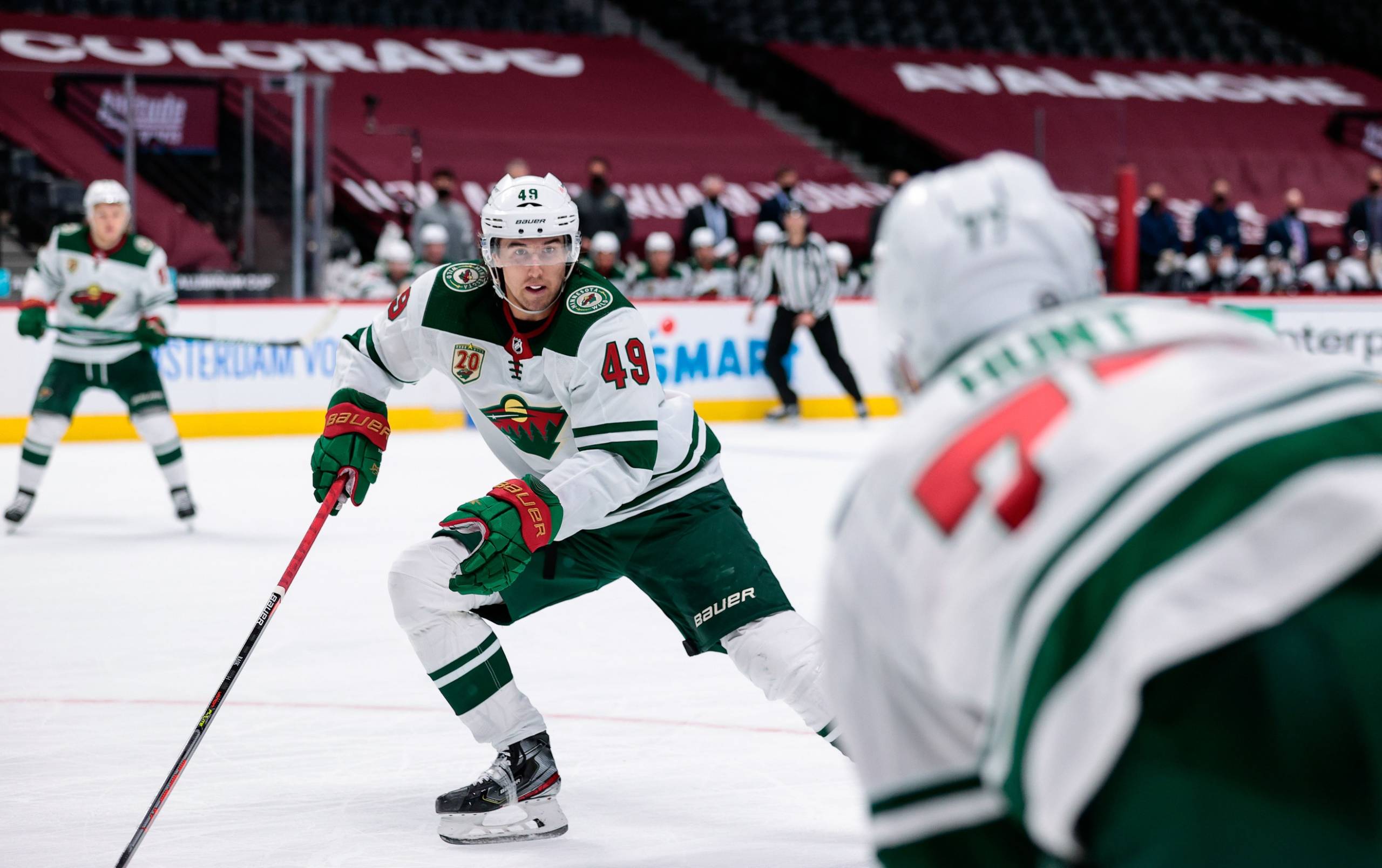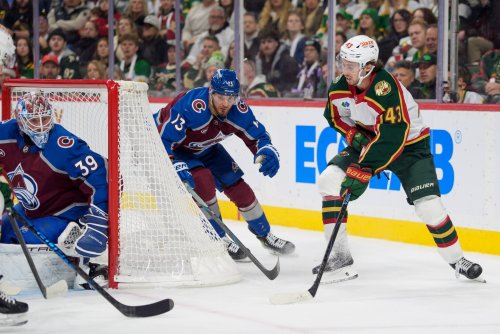
Kevin Fiala and Kirill Kaprizov. Matt Dumba and Jared Spurgeon. Mats Zuccarello and Zach Parise. It hasn’t mattered who Dean Evason placed on the power play, because the Minnesota Wild are terrible with the man advantage no matter what he does. Countless journalists, bloggers, and broadcasters have tried to diagnose the problem.
It’s not about winning faceoffs. Faceoffs are hyper-analyzed because it signals the start of play. However, statistical studies have shown that winning faceoffs does not correlate to winning games. In fact, analytics say that faceoffs shouldn’t be tracked or have any more meaning than any other puck battle in which possession can be won. So while the Wild struggle to win faceoffs all over the ice and in all situations, losing faceoffs isn’t what is plaguing the power play.
If the Wild aren’t winning the faceoffs to start in the offensive zone, they’ll need to enter the zone and either maintain possession or reacquire the puck from a dump-in. These entries are so important because of the offside rule. The penalty kill can line up along the blue line and make controlled entries difficult. The PK wants the power play to relinquish control of the puck. It takes less energy to chase down a loose puck and clear the zone than it does to chase down a skilled player and forcibly remove the puck from them (unless that player is Victor Rask).
Minnesota’s strategy isn’t at fault here. They are entering the zone the way they must to give them the best chance to score. Analysts have shown that while dump-ins and chip-ins are more successful at entering the zone, controlled entries directly lead to more zone time and more shots. And while there are some issues with executing this strategy consistently, the thinking is correct.
This team has players who can score. Fiala has 18 career power-play goals, 13 of which have come during the current season and last. Parise has 69 PPGs in nine seasons with Minnesota and 120 for his career. While Parise isn’t the player he once was, you’d think he can still be an asset to a struggling power play. Dumba and Spurgeon have combined for 54 goals on the man advantage. Adding Kaprizov to the fold should yield more results. So far, it hasn’t.
So how can a team like the Wild — a team so damn good at 5-on-5 (they are sixth in the NHL in GF% and fourth in Goals For per hour) — be so brutally offensive to most of the five senses on the power play?
The answer is simple: They make it easy for opponents to defend against their power play.
At 5-on-5, the Wild utilize a tenacious backcheck to strip the puck from the puck carrier. It allows them to strike in transition. But when the team has established their presence in the offensive zone, they do a good job with scissor plays and switches to create confusion. Typically this is done through a cycle along the boards, deep in the zone near the corner. However, Evason has employed a high cycle. In the same fashion that a low cycle forces defensemen to move their feet and eventually creates open passing lanes, a high cycle does this against forwards, who are not as adept at defending.
The high cycle creates these little “player vortices” where the puck is in constant motion, and players back-fill the puck handler's vacated areas. Watch the example below. Once the puck moves from the goal line to the point, Ryan Suter makes a D-to-D pass to an open Spurgeon. Spurgeon passes the puck down to Zuccarello. I’ve highlighted how the two commence a scissor play, where the two cross paths along the boards. This forces the Coyotes' defenseman to make a choice: stay with Zuccarello, or play the drop pass to Spurgeon.
This confusion between the Arizona forward and defense allows Zuccarello enough space to get open near the blue line. Then, as Zuccarello curls to keep the puck in the zone, Kaprizov fills the open ice that Zuccarello just vacated. Kaprizov has space to make a play, and the switch allowed Zuccarello to shed the players who were trying to keep him in check.
In another example, Kaprizov begins the high cycle after he obtains puck possession deep in the corner. Arizona forward Nick Schmaltz is pursuing Kaprizov up the wall and cannot knock him off the puck. Notice how Kaprizov and Dumba perform a switch when No. 97 approaches the blue line. The rookie phenom chooses not to pass to Dumba, who made himself available. Yet, still pestered by Schmaltz, Zuccarello moves to the high slot and receives a pass from Kaprizov. Schmaltz bites on the pass. Zuccarello was in a shooting position and was the threat. However, he lost Kaprizov in all of the confusion, and no one picked up where he left off. Zuccarello finds Kaprizov with a perfect seam pass.
Then, to cap the play off with a goal, Kaprizov draws the attention of both Coyote defensemen. Nick Bjugstad is now available for a pass, if Kaprizov can just get him the puck after the two perform another switch near the net. Kaprizov makes a perfect play, and Bjugstad has an easy tap-in for the goal.
When the Wild are clipping along and feeling good about their game, this is the kind of chaos and havoc they can create at 5-on-5. This movement — the mini vortices and cyclone action — is starkly absent from their power play.
Once Minnesota establishes control in the offensive zone, the team spreads out into different zones. It’s a lot like a zone defense, but on offense. Each player is set in their general areas, and the skating between each area is minimal.
In this next example, it’s striking to see how noticeable the “bubbles” are. The PK is allowed to remain in their defensive box and doesn’t have to worry about any switches or cycles. Defensemen don’t have to chase. Instead, the defense can block the shooting lanes and passing lanes while the Wild attempt to pass around the box looking for an open puck shooter.
In one final image, Jordan Greenway holds the puck in the corner, and all 10 players on the ice are in the frame (minus the Wild's goaltender). The Wild are stagnant in the positioning, and the four purple jerseys of the Kings are in a near-perfect box. Greenway provides a low threat from that shooting angle, and the two Wild players in the slot are covered expertly.
The Wild aren’t converting on the power play because they don’t create the same kind of havoc and confusion when they have the advantage of having more players on the ice. While others talk about faceoffs, shooting, or even adding Matt Boldy to help with the struggling power play, the strategy isn’t nearly as good as it should be. On paper, the Wild should be better than they have shown. The talent level is increasing. Evason just needs to figure out how to create the same kind of action that he’s found at 5-on-5.
Think you could write a story like this? Hockey Wilderness wants you to develop your voice, find an audience, and we'll pay you to do it. Just fill out this form.








Recommended Comments
There are no comments to display.
Join the conversation
You can post now and register later. If you have an account, sign in now to post with your account.
Note: Your post will require moderator approval before it will be visible.